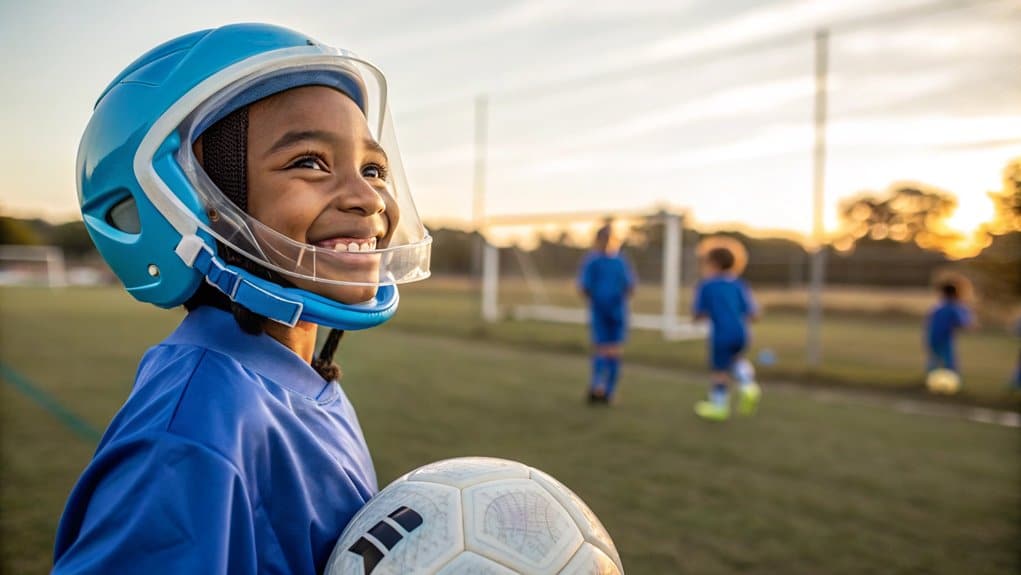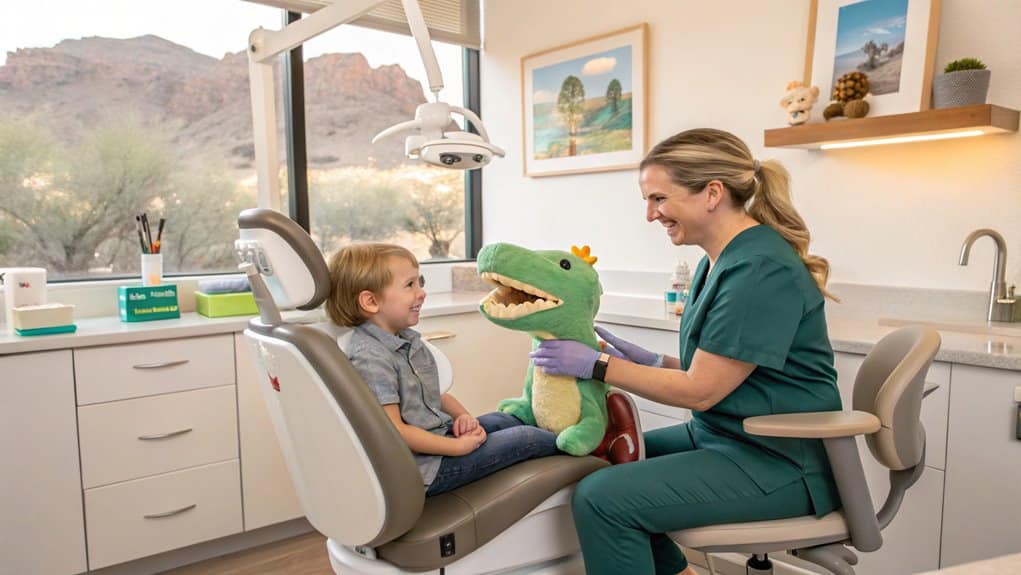How Can Chandler Families Reduce the Risk of Dental Trauma During Kids’ Sports Activities?
Quick Take: Chandler families can effectively reduce the risk of dental trauma in youth sports by adopting comprehensive safety measures and using custom-fitted protective gear.
Sports provide children with valuable life lessons and physical benefits, but they also come with the risk of dental injuries—especially in activities involving contact or fast-moving equipment. For Chandler families, protecting young athletes starts with awareness and proactive care that prevents injuries before they happen.
Simple steps such as using custom-fitted mouthguards from local dental professionals, inspecting gear regularly, and scheduling pre-season dental checkups can make all the difference. When combined with proper coaching, safe play guidelines, and emergency readiness, these habits help families keep sports fun, safe, and free from preventable dental trauma.
Key Takeaways
- Get custom-fitted mouthguards from local dental professionals to provide the best protection during sports activities.
- Schedule dental check-ups before the season starts to spot any oral health concerns and get properly fitted protective gear.
- Make sure your child consistently wears the right protective equipment during both practice sessions and games.
- Learn how to respond to dental emergencies, such as how to care for a knocked-out tooth and when to seek immediate dental attention.
- Work with coaches and dental experts to develop safety measures and strategies to prevent injuries.
Understanding Dental Trauma Risks in Youth Sports
Key Insight: Dental injuries rank among the most prevalent yet underestimated risks in youth sports, affecting nearly 40% of young athletes engaged in various activities. Recognizing these risks helps parents and coaches implement effective prevention strategies beyond typical bone and joint injury concerns.
Focusing solely on fractures and sprains overlooks the substantial impact of dental trauma on children’s overall health and athletic participation. Data reveal that boys and 12-year-olds are disproportionately affected, emphasizing the need for targeted protective measures during critical developmental stages. Dental injuries frequently occur during routine practices, highlighting often-neglected vulnerability periods that require enhanced supervision and protective gear.
Critical insights into youth sports dental trauma reveal these key risk factors and contexts:
- Boys experience higher dental injury rates compared to girls, indicating gender-specific risk dynamics.
- Children around age 12 face the greatest incidence, correlating with mixed dentition and active engagement in contact sports.
- Basketball outpaces traditional contact sports in emergency visits for dental trauma, underscoring varied sport-specific risks.
- Non-contact activities like skateboarding and cycling contribute significantly to dental injuries, broadening the scope beyond team sports.
- Over 87% of dental trauma cases occur during practices, not games, spotlighting training sessions as high-risk environments.
These insights call for a paradigm shift in how parents, coaches, and healthcare professionals approach injury prevention in youth sports. By integrating sport-specific dental protection, emphasizing consistent use of mouthguards, and educating young athletes on risk awareness, stakeholders can substantially reduce dental trauma cases. That’s why a proactive, informed mindset is essential to safeguarding young athletes’ smiles and ensuring their long-term well-being on and off the field. Additionally, partnering with a pediatric dentist can provide specialized guidance on effective dental care and protection strategies for young athletes.
The Essential Role of Mouthguards in Prevention
Key Insight: Mouthguards are essential protective gear that significantly reduce the risk of dental injuries in young athletes, combining comfort and advanced technology for optimal safety during sports.
Advancements in mouthguard design have enhanced their effectiveness, making them indispensable for preventing dental trauma in contact and high-impact sports. Athletes who consistently wear mouthguards benefit from superior protection against tooth fractures, lip lacerations, and jaw injuries, promoting long-term oral health and athletic performance. Integrating mouthguards into regular sports safety protocols aligns with best practices endorsed by dental and sports medicine experts.
Selecting the appropriate type of mouthguard depends on factors such as fit, comfort, and level of protection required for the sport. That’s why understanding the options available helps athletes and parents make informed decisions that balance convenience and efficacy. Custom-fitted mouthguards, for example, offer tailored cushioning and stability, whereas boil-and-bite guards provide accessible customization. Stock mouthguards, while less adaptable, remain better than no protection at all.
For optimal dental injury prevention, consider these key mouthguard options and their distinct advantages:
- Custom-made mouthguards crafted by dental professionals deliver precise fit, enhanced shock absorption, and superior durability.
- Boil-and-bite mouthguards allow semi-custom fitting via heat molding, offering moderate protection with user-friendly adjustments.
- Stock mouthguards provide immediate availability and basic coverage, suitable for casual or occasional athletes.
- Advanced materials in modern mouthguards improve breathability and reduce speech interference, addressing common comfort concerns.
- Consistent use of mouthguards during training and competition significantly lowers the incidence of traumatic dental injuries, as supported by clinical research.
- Custom-fitted mouthguards ensure a better fit and comfort, enhancing overall effectiveness in protecting young athletes.
Emergency Response and First Aid for Sports-Related Dental Injuries
Key Insight: Prompt and informed emergency response for sports-related dental injuries can preserve dental health, reduce complications, and lower long-term treatment costs.
Rapid and knowledgeable action following a dental trauma during sports activities significantly improves prognosis and minimizes permanent damage. Coaches, parents, and athletic staff must be equipped with not only a well-stocked dental first-aid kit but also the expertise to apply emergency protocols effectively. This preparedness translates into fewer invasive procedures and enhanced oral function for injured athletes. Understanding the nuances of dental trauma management fosters confidence and swift intervention during critical moments.
That’s why comprehensive emergency response training includes recognizing different injury types, appropriate preservation methods, and timely professional referrals. In addition to immediate care, prevention strategies such as custom-fitted mouthguards remain essential to reduce injury incidence and severity. Combining prevention with acute care knowledge creates a resilient approach to dental trauma in sports environments, optimizing recovery outcomes and protecting athletes’ long-term oral health. Furthermore, having access to specialized pediatric dental services can ensure that young athletes receive the appropriate care tailored to their needs.
Essential emergency response actions for sports-related dental injuries include:
- Handling avulsed (knocked-out) teeth by the crown only to avoid root damage and storing them in milk or saline to preserve periodontal ligament cells.
- Applying cold compresses promptly to mitigate soft tissue swelling and inflammation, reducing pain and secondary complications.
- Using sterile gauze to control bleeding effectively without causing additional tissue trauma.
- Saving any fractured tooth fragments for potential reattachment, enhancing restorative options.
- Protecting sharp edges of chipped or cracked teeth with dental wax or temporary materials to prevent oral lacerations.
- Prioritizing immediate dental evaluation, especially when symptoms include severe pain, persistent bleeding, or airway difficulty, to ensure comprehensive assessment and treatment.
Adopting a proactive mindset toward dental trauma—embracing preparedness, prevention, and prompt action—creates a safety net that safeguards athletes’ smiles and well-being. Stakeholders become empowered to act decisively, improving recovery trajectories and reducing costly complications. Integrating these expert practices into athletic programs nurtures a culture of safety and resilience, reinforcing the critical role of dental emergency response in sports health management.
Safe Play Guidelines for Chandler’s Summer Sports Scene
Key Insight: Prioritizing dental safety in Chandler’s summer sports not only prevents injuries but enhances long-term oral health and athletic performance, integrating hydration, protective gear, and education into a holistic approach.
As a result of intense summer heat and active sports participation, athletes face heightened risks of dental injuries and oral health challenges. Inadequate hydration and improper equipment use can exacerbate enamel erosion, gum irritation, and traumatic dental incidents. That’s why Chandler’s sports programs emphasize comprehensive safety protocols that align with best practices in dental care and athletic injury prevention.
Combining expert guidance on mouthguard fitting with education on nutrition and hydration fosters resilient athletes capable of maintaining peak performance during rigorous summer activities. Coordinated efforts among coaches, parents, and dental professionals create a supportive environment that emphasizes proactive oral health maintenance alongside physical safety.
Key safety strategies integrated into Chandler’s summer sports culture include:
- Wearing custom-fitted mouthguards and face protection to minimize dental trauma risk.
- Maintaining optimal hydration primarily through water to protect enamel integrity and reduce dry mouth.
- Avoiding sugary sports beverages that contribute to acid erosion and cavities during physical exertion.
- Conducting routine inspections of playing fields and equipment to identify and eliminate potential hazards.
- Enforcing coach-led safe play techniques that reduce collision incidents and promote sportsmanship.
- Encouraging regular dental check-ups pre-season to ensure athletes’ readiness and tailor protective equipment.
- Collaborating with local pediatric dental services to educate families about maintaining oral health during sports activities.
Fostering a mindset that values dental safety as integral to athletic success encourages sustained participation and well-being. By embracing these layered preventive measures, athletes empower themselves to compete confidently and minimize avoidable oral injuries. Continuous collaboration between local dental experts, sports organizers, and families remains essential for evolving best practices that adapt to Chandler’s dynamic summer sports environment.
Building a Community-Wide Dental Safety Network
Key Insight: Building a comprehensive dental safety network in Chandler hinges on strategic collaboration among dental experts, sports bodies, and educational institutions to safeguard young athletes’ oral health effectively. This integrated approach not only minimizes injury risks but also fosters a community culture centered on proactive dental care and emergency preparedness.
Engaging local dentists and orthodontists in preseason screenings and custom mouthguard fittings creates a preventative foundation that directly reduces sports-related dental trauma. Schools and sports organizations adopting clear emergency protocols and insurance frameworks ensure timely, coordinated responses when injuries occur, enhancing overall safety outcomes. These aligned efforts transform Chandler’s community into a model of dental injury prevention and management.
Building this network involves multiple facets that collectively optimize oral safety and response capabilities:
- Preseason dental evaluations by professionals identify vulnerabilities, and fit protective gear tailored to athletes’ needs.
- Emergency protocol implementation by schools and leagues standardizes immediate care and communication pathways.
- Educational workshops at community centers empower coaches and parents with practical knowledge on injury prevention and first aid techniques.
- Centralized injury reporting systems enable data-driven insights to pinpoint high-risk activities and inform safety improvements.
- Priority access to local dental clinics ensures swift treatment for sports-related emergencies, minimizing long-term damage.
- Direct communication channels between school nurses, coaches, and dental providers promote continuous monitoring and support.
Cultivating such a multifaceted dental safety network elevates Chandler’s capacity to protect young athletes’ smiles while promoting safe sports participation. That’s why investing in these collaborative partnerships and data-informed strategies is critical for sustained community health. Furthermore, working with pediatric dentistry specialists ensures that children receive tailored care suited to their unique developmental needs. Leveraging technology and ongoing education will further enhance prevention and response, empowering every stakeholder to contribute confidently to dental safety excellence.
In Summary
Protecting young athletes’ smiles starts with proper dental safety and teamwork between parents, coaches, and dental professionals. Wearing custom mouthguards, following safety guidelines, and staying alert to risks all help create a secure sports environment where kids can play confidently and avoid preventable injuries.
At Palm Valley Pediatric Dentistry & Orthodontics, we’re proud to help families in Scottsdale, East Mesa, Chandler, and nearby areas protect their children’s dental health. Our expert team offers guidance, preventive care, and support to keep young athletes’ smiles strong and safe—on and off the field.







